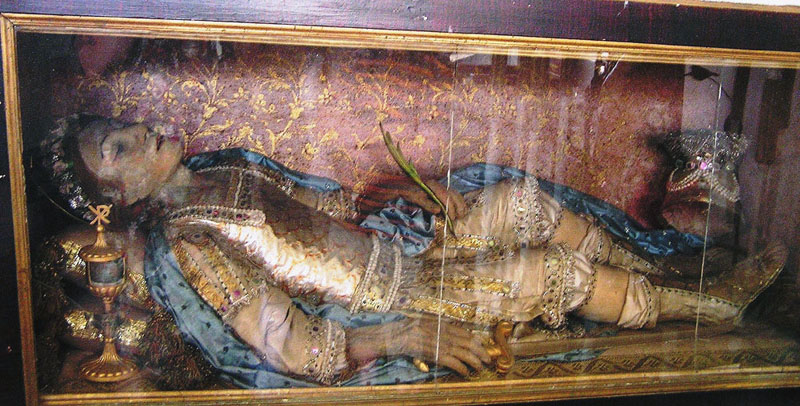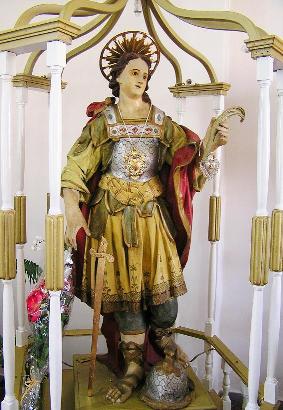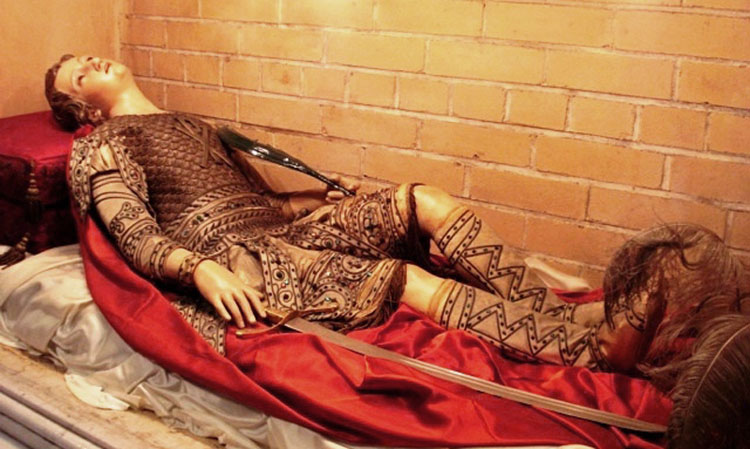
San Vincenzo, Martyr of Craco
Encyclopedia
San Vincenzo Martire is a minor saint of the Roman Catholic Church
. He is remembered in devotions by the people of Craco
, Italy
and immigrants and their descendants from that town who settled in North America. San Vincenzo's feast day is celebrated on the fourth Sunday of October in Craco, Italy and Manhattan, New York.
, a legion of soldiers who converted en masse to Christianity and who were martyred for refusal to participate in sacrifices to the Roman emperor prior to battle in the year 286 AD.
in the Province of Matera is the site of the former Friary of the Franciscans. The building of the Friary began on April 3, 1620 by a Friar named Robert, the then Bishop of Tricarico, and was finally completed ten years later in 1630. The Friary bore the name of St. Peter, Prince of the Apostles, and was entrusted to the care of the Franciscan Friars who retained it until the Italian Government suppressed it in 1866.
Next to this Friary was a beautiful church to the left of which, in 1777, a rather large chapel was built. This chapel was dedicated to San Vincenzo Martire in the year 1793.
On February 6, 1769, a small bone relic
of San Vincenzo was sent to Craco from Rome. Then in 1792, Fr. Prospero, a Franciscan from Craco, finding himself in Rome, and wishing to return home with a relic of some glorious martyr, obtained from Pope Pius VI, through the Sacred Congregation of Rites, a relic which was said to be that of a Roman soldier as well as a glorious martyr, by the name of Vincenzo – a name signifying “winner” or “conqueror.” The “sacred body with a flask of blood” of San Vincenzo Martire was exhumed at the cemetery of St. Ciriaca, in Rome. Fr. Prospero enclosed the precious relic in an artistic crystal-sided casket. Inside the casket was set the waxen body of the martyr, dressed as a Roman soldier and lying in a reclining position.
Stopping at various places during the course of its journey from Rome, the remains were carried all the way to Craco where it was received with great pomp and honor by the local clergy and townspeople. The great devotion of the faithful in the region and neighboring towns rendered great honor to the soldier martyr San Vincenzo. In large measure, this was due to the many miracles reportedly performed by the Saint for the suffering multitudes that sought his help.
The holy relic of San Vincenzo arrived in Craco on June 4, 1792. The clergy and the people of Craco decided to choose San Vincenzo, along with San Nicola of Bari, as their patron and protector of the town. The religious and civil festival of San Vincenzo was fixed for the fourth Sunday of October to coincide with the important annual fair which takes place after the harvest. On April 4, 1793 the relic of San Vincenzo was installed in the chapel at the Friary and remained there until the late 1980s when structural instability required the relic to be relocated to a small chapel in the Sant’Angelo section of Craco where it resides today. Although the Friary dedicated to St. Peter served as his home, the overwhelming majority of the population of Craco still calls it "the Convent of San Vincenzo."

The relic of San Vincenzo in Craco, Italy

The processional statue of San Vincenzo in Craco, Italy
In 1901 this group associated itself with St. Joachim's Church, formerly located at 28 Roosevelt St., providing the church with a statue that is a copy of the reclining relic of San Vincenzo in Craco, the 1769 bone relic from Craco, and a handwritten copy of the original novena as said in Craco. The first celebration of the feast of San Vincenzo Martire in New York City's Little Italy was held on Saturday and Sunday October 24 - 25, 1901. The Societa San Vincenzo Martire di Craco continued to maintain the traditional celebration of the feast on the fourth Sunday of October until 1941. With the onset of WWII, the celebration of the feast was suspended although the religious celebration of a special Mass continued. In 1952, the Società San Vincenzo Martire di Craco was dissolved.
Individual devotees, all descendants of the Crachesi immigrants, continued sponsoring the religious celebration of a special Mass for San Vincenzo Martire at St. Joachim's Church. In 1957, an urban renewal project, ordered by the City of New York, dictated the closing of the church in 1958, and required the relocation of the statues before the church was demolished.
The statue, which is a copy of the reclining relic of San Vincenzo in Craco, and the bone relic from 1769 were relocated to the Church of St. Joseph, 5 Monroe Street, Manhattan where arrangements were made for the religious celebration of a special Mass annually. The upright processional statue was placed at St. Rosalia – Regina Pacis Parish in Brooklyn, but was lost to the effects of time.
St. Joseph's Church still maintains the feast day by celebrating a special Mass on the fourth Sunday in October.

The reclining statue of San Vincenzo in St. Joseph's Church, NYC
Roman Catholic Church
The Catholic Church, also known as the Roman Catholic Church, is the world's largest Christian church, with over a billion members. Led by the Pope, it defines its mission as spreading the gospel of Jesus Christ, administering the sacraments and exercising charity...
. He is remembered in devotions by the people of Craco
Craco
Craco is a commune and medieval village located in the Region of Basilicata and the Province of Matera in Italy. About 25 miles inland from the Gulf of Taranto at the instep of the “boot” of Italy...
, Italy
Italy
Italy , officially the Italian Republic languages]] under the European Charter for Regional or Minority Languages. In each of these, Italy's official name is as follows:;;;;;;;;), is a unitary parliamentary republic in South-Central Europe. To the north it borders France, Switzerland, Austria and...
and immigrants and their descendants from that town who settled in North America. San Vincenzo's feast day is celebrated on the fourth Sunday of October in Craco, Italy and Manhattan, New York.
The Origin of San Vincenzo Martire
San Vincenzo is said to have been one of the Theban LegionTheban Legion
The Theban Legion figures in Christian hagiography as an entire Roman legion — of "six thousand six hundred and sixty-six men" — who had converted en masse to Christianity and were martyred together, in 286, according to the hagiographies of Saint Maurice, the chief among the Legion's...
, a legion of soldiers who converted en masse to Christianity and who were martyred for refusal to participate in sacrifices to the Roman emperor prior to battle in the year 286 AD.
Origin of the Devotion to San Vincenzo
The village of CracoCraco
Craco is a commune and medieval village located in the Region of Basilicata and the Province of Matera in Italy. About 25 miles inland from the Gulf of Taranto at the instep of the “boot” of Italy...
in the Province of Matera is the site of the former Friary of the Franciscans. The building of the Friary began on April 3, 1620 by a Friar named Robert, the then Bishop of Tricarico, and was finally completed ten years later in 1630. The Friary bore the name of St. Peter, Prince of the Apostles, and was entrusted to the care of the Franciscan Friars who retained it until the Italian Government suppressed it in 1866.
Next to this Friary was a beautiful church to the left of which, in 1777, a rather large chapel was built. This chapel was dedicated to San Vincenzo Martire in the year 1793.
On February 6, 1769, a small bone relic
Relic
In religion, a relic is a part of the body of a saint or a venerated person, or else another type of ancient religious object, carefully preserved for purposes of veneration or as a tangible memorial...
of San Vincenzo was sent to Craco from Rome. Then in 1792, Fr. Prospero, a Franciscan from Craco, finding himself in Rome, and wishing to return home with a relic of some glorious martyr, obtained from Pope Pius VI, through the Sacred Congregation of Rites, a relic which was said to be that of a Roman soldier as well as a glorious martyr, by the name of Vincenzo – a name signifying “winner” or “conqueror.” The “sacred body with a flask of blood” of San Vincenzo Martire was exhumed at the cemetery of St. Ciriaca, in Rome. Fr. Prospero enclosed the precious relic in an artistic crystal-sided casket. Inside the casket was set the waxen body of the martyr, dressed as a Roman soldier and lying in a reclining position.
Stopping at various places during the course of its journey from Rome, the remains were carried all the way to Craco where it was received with great pomp and honor by the local clergy and townspeople. The great devotion of the faithful in the region and neighboring towns rendered great honor to the soldier martyr San Vincenzo. In large measure, this was due to the many miracles reportedly performed by the Saint for the suffering multitudes that sought his help.
The holy relic of San Vincenzo arrived in Craco on June 4, 1792. The clergy and the people of Craco decided to choose San Vincenzo, along with San Nicola of Bari, as their patron and protector of the town. The religious and civil festival of San Vincenzo was fixed for the fourth Sunday of October to coincide with the important annual fair which takes place after the harvest. On April 4, 1793 the relic of San Vincenzo was installed in the chapel at the Friary and remained there until the late 1980s when structural instability required the relic to be relocated to a small chapel in the Sant’Angelo section of Craco where it resides today. Although the Friary dedicated to St. Peter served as his home, the overwhelming majority of the population of Craco still calls it "the Convent of San Vincenzo."

The relic of San Vincenzo in Craco, Italy
The Feast of San Vincenzo
Traditionally, the feast in Craco celebrating San Vincenzo began nine days before the fourth Sunday in October with the recitation of solemn afternoon novenas. On one of those evenings, a small procession took place, with a statue representing the upright figure of the relic, starting from the Chapel and moving around the "Cross", then located at the entrance to the town. On Friday evening, after the novena, the statue of the saint was brought into the Chiesa Madre [Church of San Nicola] located in the heart of the old town. On Saturday evening, before the feast day, the statue was carried in procession back to the chapel that served as its home. All celebrations culminated on Sunday with the Mass at the Friary and the procession that crossed the entire town. That evening, in front of the Palazzo Rigirone, there were bright fireworks displays.
The processional statue of San Vincenzo in Craco, Italy
The Fair
The feast in honor of San Vincenzo was always preceded on the Saturday before by a fair, a proud tradition carried out since the end of the 18th century until today. The fair, traditionally known by all the nearby people and neighboring towns, brought many people from Salandra, Fernandina, Montalbano and Pisticci. The fair branched from the entrance of Craco to the other end of the town, at the drinking trough. It was held at the time of the year when workers of the earth were engaged in preparing land for planting or harvesting olives. But on that day, all work ceased so the people could make major purchases at the fair. Animals of all types, as well as foodstuffs: dried beans, “winter” apples, and dried peppers that would be used to season salami were available. This served as a way for people to purchase provisions for the long winter that awaited the rural population.Confraternity of San Vincenzo Martire'
Until the early decades of the 20th century a confraternity of devout worshippers of San Vincenzo existed in Craco. Those belonging to the confraternity were characterized by wearing a white tunic with a turquoise cape and belt. This group took part in the Mass, processions, and upon request also at funerals.San Vincenzo Martire in New York
With immigration to America at the turn of the 20th century, the Crachesi brought the devotion to their patron saint with them. In 1899 they formed a mutual aid society, the Società San Vincenzo Martire di Craco.In 1901 this group associated itself with St. Joachim's Church, formerly located at 28 Roosevelt St., providing the church with a statue that is a copy of the reclining relic of San Vincenzo in Craco, the 1769 bone relic from Craco, and a handwritten copy of the original novena as said in Craco. The first celebration of the feast of San Vincenzo Martire in New York City's Little Italy was held on Saturday and Sunday October 24 - 25, 1901. The Societa San Vincenzo Martire di Craco continued to maintain the traditional celebration of the feast on the fourth Sunday of October until 1941. With the onset of WWII, the celebration of the feast was suspended although the religious celebration of a special Mass continued. In 1952, the Società San Vincenzo Martire di Craco was dissolved.
Individual devotees, all descendants of the Crachesi immigrants, continued sponsoring the religious celebration of a special Mass for San Vincenzo Martire at St. Joachim's Church. In 1957, an urban renewal project, ordered by the City of New York, dictated the closing of the church in 1958, and required the relocation of the statues before the church was demolished.
The statue, which is a copy of the reclining relic of San Vincenzo in Craco, and the bone relic from 1769 were relocated to the Church of St. Joseph, 5 Monroe Street, Manhattan where arrangements were made for the religious celebration of a special Mass annually. The upright processional statue was placed at St. Rosalia – Regina Pacis Parish in Brooklyn, but was lost to the effects of time.
St. Joseph's Church still maintains the feast day by celebrating a special Mass on the fourth Sunday in October.

The reclining statue of San Vincenzo in St. Joseph's Church, NYC

